|
Marsimek-La - The Highest Motorable Pass in the World
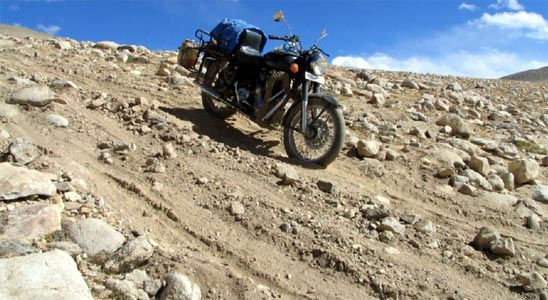
Hundreds of bikers ride to Leh every year and subsequently to Khardung-La, 52 kms from Leh. Khardung-La, at an altitude of 18,380 feet is also known as the highest motorable pass in the world.
But recently, a little know pass in Changthang has bikers searching for more information. To the north-east of Khardung-La and below the Karakoram range lies Marsimek-La / Marsmik-La / Marsimik-La.
Few facts about Marsimek-La
- The name of the pass is spelt as Marsimek-La and not Marsimik-La nor Marsmik-La (referring to several articles on the internet).
- Why is Khardung-La at 18,380 feet still called the highest motorable pass when Marsimek-La stands at an altitude of 18,634 feet?
Firstly, while the Khardung-La pass above the road probably stands at 18,380 feet, the road below the pass stands at around 17,580 feet. All roads leading to the Indian Borders are made by BRO (Border Roads Organisation), an Army outfit. Although the real reason behind the inflation to make a record breaking pass might never be known, but I can safely assume that Marsimek-La is not hyped because firstly it is built by the ITBP (Indo Tibetan Border Police) and not the BRO.
Secondly, the Army authorities probably think it best not to advertise the pass and invite civilian traffic to the border area. The track to Marsimek-La leads to the border posts and is used to ferry food and other supplies there.
Route:
Marsimek-La is on the northern-most tip of the Changthang Plateau. 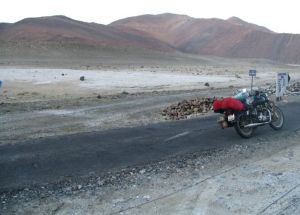 Take the road from Leh towards Pangong-Tso via the Chang-La pass. Just meters before Pangong-Tso, a dirt track breaks to the left. The track is so small that if your not alert, you will miss it. This track will take you to Marsimek-La. The pass is still 32 kms away from this turn. Take the road from Leh towards Pangong-Tso via the Chang-La pass. Just meters before Pangong-Tso, a dirt track breaks to the left. The track is so small that if your not alert, you will miss it. This track will take you to Marsimek-La. The pass is still 32 kms away from this turn.
Ten kms on and riding over two not-so-high passes, you will reach Phobrang. The rough and loose track enroute is a sign of what lies between you and Marsimek-La after Phobrang.
There is an ITBP Post at Phobrang. The chaps are always welcoming and offer all possible assistance; but fail to understand why someone would want to ride upto to the pass where even their 4x4 vehicles struggle.
The Phobrang ITBP camp is the place where one should remove all the luggage from the bike, except for the tool kit. The bike needs to be lighter so it can negotiate the stiff incline before the pass.
Marsimek-La is now lies 22 kms ahead. The track climbs up from Phobrang instantly. 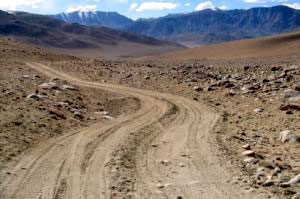 The first 18 kms is a dirt track crossing several mountains. No valley on either side of the track - it's just riding in middle of a mountain. It is all sand and gravel and the track is inclined to your left. To add to that, there is lots of loose dirt which makes the bike go haywire. But nothing that would really pose a threat to the bike or the biker. The first 18 kms is a dirt track crossing several mountains. No valley on either side of the track - it's just riding in middle of a mountain. It is all sand and gravel and the track is inclined to your left. To add to that, there is lots of loose dirt which makes the bike go haywire. But nothing that would really pose a threat to the bike or the biker.
There are no passes or sub passes for these 18 kms, the road relatively straight, barring few loops and hairpin bends.
Just when one is captivated by the vast and empty landscape, a steep sandy climb breaks the trance and you will know it's time to rock and roll. The stretch from here on is an arrogant incline full of sand and boulders. From here on no matter what bike you have, 350cc, 500cc, RD350 or 750cc interceptor, it will stall. The bike cannot climb through the sand, just not possible since it bogs down into it. The loose sand on and before the incline is a result of the heavy Army vehicles spinning their knobbly tyres before the climb.
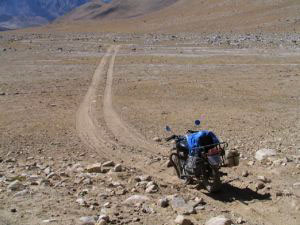 The trick is to bring the bike in good speed with as much momentum and climb as far as you can. Once it stalls (it is bound to), get down and start pushing the bike :-) Take a break, restart the bike and push it again. The trick is to bring the bike in good speed with as much momentum and climb as far as you can. Once it stalls (it is bound to), get down and start pushing the bike :-) Take a break, restart the bike and push it again.
But at 18,000 feet, there is hardly any oxygen for the bike and the rider. Few meters of pushing and you have to halt for a breather and the moment you stop for a break, the bike sinks more into the sand! Pulling it out of course needs extra effort.
Taking 10 steps up that incline at 17,000+ feet is an ordeal. It's a combination of you and your bike not getting enough oxygen under extremely testing conditions which takes the maximum toll. The road conditions are next to impossible to be driven through even with the maximum oxygen available, least of all at that altitude. Low oxygen for your own lungs, also means lesser energy in you to handle or push the bike.
The last 3-3.5 kms before the pass is not a fair battle between bike and mountain. From here onwards you take the bike, I mean push it, rather than ride it to the top. It's more of physical strength than riding skill, also the mental toughness. And most importantly - the adamant attitude to reach the top, no matter what. Here Marsimek-La will test every rider and bike.
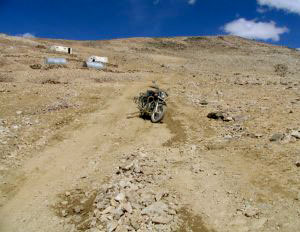 The incline is just 70 mts, but to cross that, you will pant like a dog. You'll feel like ripping all your clothes just for a breath of air, your head spinning with dizziness. The incline is just 70 mts, but to cross that, you will pant like a dog. You'll feel like ripping all your clothes just for a breath of air, your head spinning with dizziness.
Once this incline is crossed, a slightly inclined plateau lies ahead, housing many abandoned army huts. Another set of hairpin bends, few inclines and you will be welcomed by a sight of prayer flags, welcoming you to Marsimek-La.
The ecstasy after the agony to reach the pass cannot be described in words, but on sight of the milestone, all the fatigue goes away.
It proudly reads -
CHAK DE
MAPSIMEK - LA
WORLD'S HIGHEST MOTORABLE PASS
AT ALT - 5590 MTS - 18,634 FEET
CONST BY 6FD COY
236 C/R CHAK DE
CHAK DE
Marsimek-La is misspelt on the milestone, with a "P" in place of "R".
The track to Marsimek-La was built in 1983 under the supervision of Sonam Paljore, an Everester. There is also a small temple called "Chak Mandir" which has a picture of Lord Shiva.
Marsimek-La does give the rider a tough fight; there is no way one can use his/her riding skills to get up there. It's not about adroit riding but about the mental strength of rider, a single-minded ambition to see the incline through.
Tips for Marsimek-La.
- Marsimek-La is an inner line route. You will need to obtain permission from Leh District Authorities to go there.
- Keep all your luggage at the Phobrang ITBP camp. Just carry your tool-kit and spare bag, which you might want to leave on the incline 3.5 kms before the pass.
- Tune the carburettor to supply more air to the engine, make the mixture lean. Removing the air filter also might help.
- Start the ride for M-top at 8 a.m. from Phobrang. Before 8 it will be very cold and after that high velocity winds start. You will should be at M-top by 10-10.30 a.m.
- Also read the travelogue to Marsimek-La here We have titled it Marsimik-la on the page so that the result shows up on search engines. So much for Trailblazing ;-)
HAPPY TRAILS,
Gaurav & Praveen
If you wish to add more tips which are not mentioned above,
kindly e-mail them at theride@60kph.com.
We will gladly add them to the list.
|